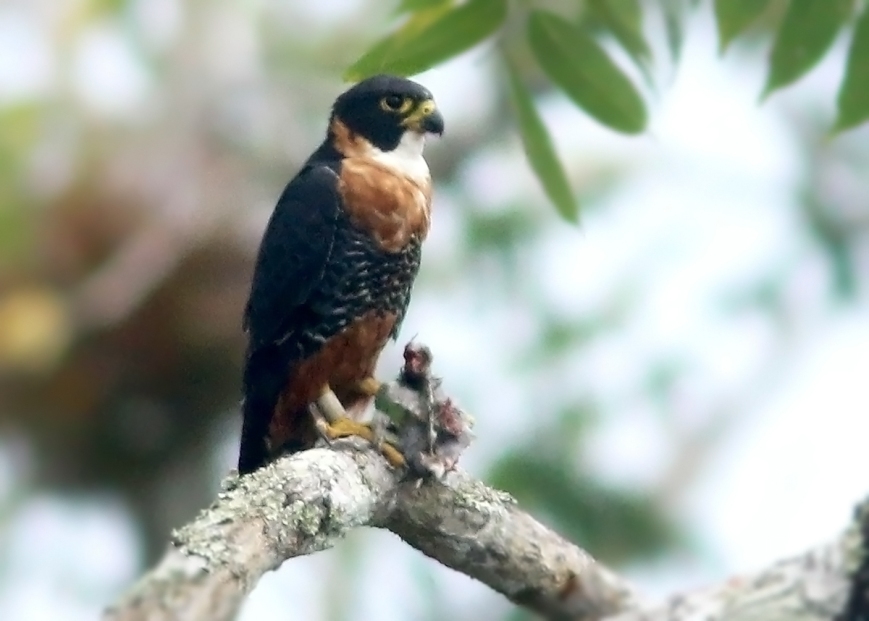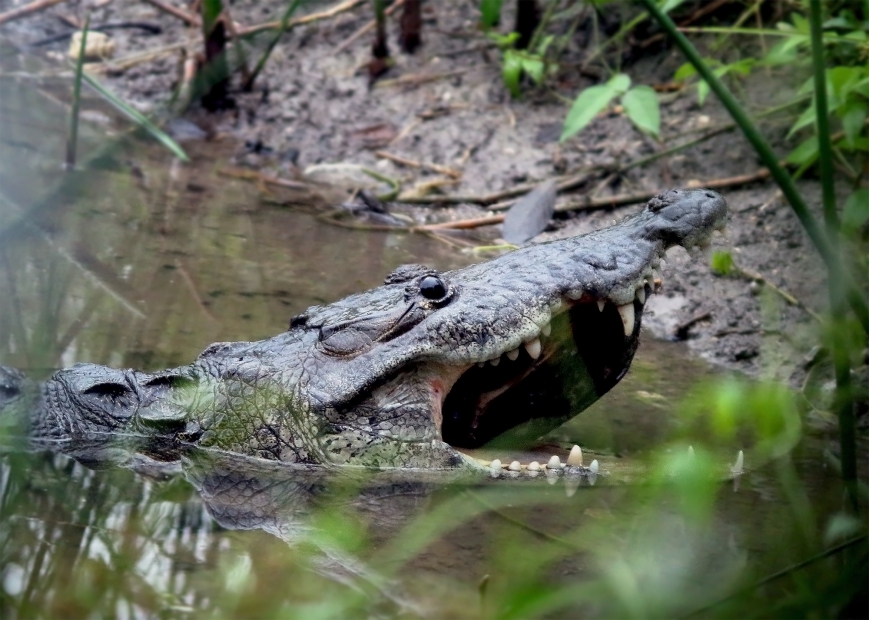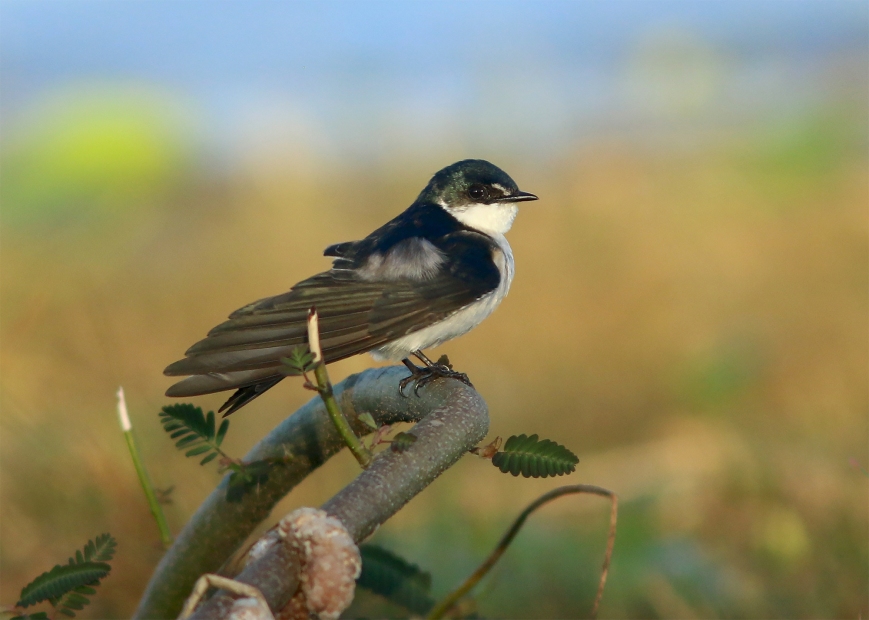A few weeks ago (February 2019), I had the wonderful opportunity to co-lead an Eagle-Eye Tours trip to Belize & Tikal — two very exciting destinations! As most of you know, I routinely lead tours at home and abroad for this excellent Canadian company (check out the bottom of this post for some upcoming trips), sharing the magic of birds & birding with lots of great people along the way. This was just my second visit to Central America, following an exploratory trip to Honduras in 2017. Fortunately, I was joining my friend and birder extraordinaire Ernesto Carman, who hails from Costa Rica and was eager to show off this incredible little corner of the world.
This tour focuses on three superb location – Pook’s Hill & Crooked Tree in Belize, and Tikal National Park in neighbouring Guatemala. The rich mix of habitats (e.g. rainforest, pine-oak savannah, and vast wetlands) along with stunning history and ancient Mayan temples makes for a well-rounded yet nature-filled trip. Below are just a few of the many, many highlights. Be sure to check out this Flickr album for even more photos (though I apologize for the quality, since most were edited on my phone during the tour).

We arrived and met in Belize City — a lovely hamlet of a city on the east coast of this beautiful country.

The birding right outside our hotel offered a nice introduction to many of the common species we would see throughout the week. Gems such as Vermillion Flycatcher, Great Kiskadee, Carib Grackle, Morelet’s Seedeater and Tropical Kingbird were easy to spot.

This Snail Kite, however, was an unexpected treat and put on a real show as it foraged land snails right along the road behind our hotel.

Heading southwest from Belize City, we made several stops throughout our first full day. The Tropical Education Centre and nearby Monkey Bay Wildlife Sanctuary (above) provided fabulous birding – including numerous target species such as Red-capped Manakin, Green Jay, Scarlet-rumped Tanager and Yellow-tailed Oriole.

The pine-oak savannah at the Tropical Education Centre was a perfect to spot to look for Grace’s Warbler — a species that remains poorly understood, partly due to their tendency to remain high in the forest canopy.

This Black Orchid (Prosthechea cochleta), found growing at Monkey Bay Wildlife Sanctuary, is the national flower of Belize.

Our next few days were spent at Pook’s Hill Lodge – a beautiful forest reserve, bird sanctuary and archaeological site in the Cayo District of Belize. The birding on and around the lodge property was phenomenal – lush rainforests and a wealth of birds at every turn. Trogons, woodpeckers, woodpeckers, hawks, antthrush … the full tropical experience in a very unique setting.

This was one of several Collared Aracari feasting on palm fruits just metres from the sitting room at Pook’s Hill Lodge.

Toucans are an iconic symbol of the tropics, familiar even to non-birders. We encountered Keel-billed Toucans (the national bird of Belize) at several locations throughout the tour. Check out those flashy bills!

Even the cabins at Pook’s Hill are unique – simple, traditional and blended with the nature that thrives around them.

We found more than a dozen species of hummingbird during the trip – not the least of which was the impressive Long-billed Hermit. This was one of several visiting feeders at Pook’s Hill.

While it was usually difficult to tear ourselves away from the birds, there was always something else to entertain and amaze. Beautiful butterflies, like this Cycadian (Eumeas sp.), were always fun to check out.

We also made a pilgrimage to Mountain Pine Ridge – famous for its beautiful overviews and fantastic raptor watching. We weren’t disappointed! Highlights included Black Hawk-Eagle, Great Black Hawk, two White Hawks, Bat Falcons, Short-tailed Hawk, and Hook-billed Kite. Even a much-wished-for (but rather unexpected) Lovely Cotinga stopped in and provided excellent scope views!!

Spectacular views of this Black-and-White Hawk-Eagle were a hands-down highlight of our morning at Mountain Pine Ridge – a day in which we ended up recording nearly 20 species of raptor!

The next stop on our journey was the incredible Tikal National Park in Guatemala. The park, a UNESCO World Heritage Site, preserves one of the most important archaeological sites in the Americas — the ancient Mayan city and temples of Tikal. The largest city of the Mayan Classical period, it was inhabited from ~600BC until its abandonment ~900AD and has a peak population of more than 100,000 people.

A strange mix of bizarre and beautiful, Ocellated Turkeys are a regional endemic that is found quite easily in and around Tikal. This one was strutting around just 100m from our cabin near the park entrance.

While it may be most famous for its ancient Mayan ruins, Tikal National Park also protects a huge swath of pristine rainforest and is one of the best birding destinations in Central America. Strolls along the park’s many trails produced great looks at prized species such as this Royal Flycatcher, Black-throated Shrike-Tanager and Chestnut Woodpecker among many others.

Orange-breasted Falcon is one of the most prized birds of this trip, and Tikal is among the most reliable places to find it. We enjoyed incredible views of a pair making its home right alongside the ancient Mayan temples of the main plaza – including this male feasting on an unfortunate Olive-throated Parakeet.

Temple II. Built in the 8th century AD, this is one of the more recent structures built in Tikal before its eventual abandonment ~900AD. The above photo of Orange-breasted Falcon was actually taken from atop this temple.

Red-lored Parrots were relatively common at Tikal. This pair was also photographed from atop Temple II, looking quite adorable as they preened each other for several minutes.

Among the other wildlife of Tikal National Park, Central American Spider Monkeys were by far the most endearing. Troupes of these social critters were often spotted swinging through the trees, at times right above and around our cabins in the park.

Also fun to watch were White-nosed Coati – an arboreal member of the raccoon family. Their long tails were constantly held high up in the air, making them easy to spot as they roamed around the park.

Not as cute (in the conventional sense!) but just as exciting were the few Morelet’s Crocodiles that we encountered during the tour. This one, at Tikal, was very patiently working on a large turtle that it had caught. After a few minutes, we heard a loud “crack” suggesting that the crocodile was most definitely succeeding.

Heading back to Belize, we spent the last few days of our adventure at the Birds Eye View Lodge in Crooked Tree. This lovely Creole community is surrounded by a large lagoon and expansive wetlands – and at this time of year (especially) is abounding with birdlife.


An early morning boat tour of the lagoon and creeks was a highlight of our time at Crooked Tree.

We spotted nearly a dozen Jabiru during our morning boat trip. Hundreds of Limpkins, White Ibis, herons, egrets and other waders were feeding in the shallow waters around Crooked Tree.

With ebbing water levels at this time of year, Crooked Tree can be a great place to look for the scarce and very secretive Agami Heron. We were fortunate to spot several foraging in the waterside tangles — certainly one of the most handsome herons in the world.

Another secretive species, we encountered several Boat-billed Heron including this unusually cooperative one. Although I’ve been lucky enough to see this species on several occasions (and in several countries), this was the first time I ever had a full, unobscured view! Check out this large eyes – perfect for nighttime hunting.

There were also hundreds of swallows hunting over the shallow waters and lagoon shores — including the beautiful Mangrove Swallow.

Among the other wildlife enjoyed throughout the tour, Black Spiny-tailed Iguanas were among the most common. This one was trying to blend into the background along a trail at Crooked Tree.

Black Howler Monkeys were possibly the most entertaining critter during our trip – their loud, guttural and downright eerie howls reverberating through the forests. This one was watching our boat as we explored a creek at Crooked Tree.

Located in northern Belize, Crooked Tree can also be a good place to find several species that are endemic to the Yucatan region. This Yucatan Flycatcher was one of several we found in the forests there.

Another regional endemic, this Yucatan Jay was part of a small group found following a trail of army ants. Such a lovely colour!

The sun set on another fantastic Eagle-Eye Tours adventure. Our group had an excellent time, finding nearly 300 species of birds and plenty of other wildlife along the way. Added to the mix were the incredible ruins at Tikal, great food, amazing scenery and lots of great people!
Be sure to check out this Flickr album for even more photos (though I apologize for the quality, since most were edited on my phone during the tour).
For details on birding with me in Newfoundland this summer:
Newfoundland Bird & Nature Tours 2019
Catch up with me on one of these upcoming Eagle-Eye Tours:
Grand Newfoundland (June 19-30 2019)
Point Pelee & Algonquin (May 6-17 2019)
New Brunswick & Grand Manan (August 16-25 2019)
Trinidad & Tobago (December 6-16 2019)
Details on the next Eagle-Eye Tours trip to Belize & Tikal:

I love this! What beautiful photo’s you took. I am going to the island of Trinidad in just over a week to go bird watching, I can hardly wait!
Thanks! Yes — it was an awesome trip. And as for Trinidad — I love that place! I’ve led three tours there, and looking forward to another next winter. You’ll have a great time.